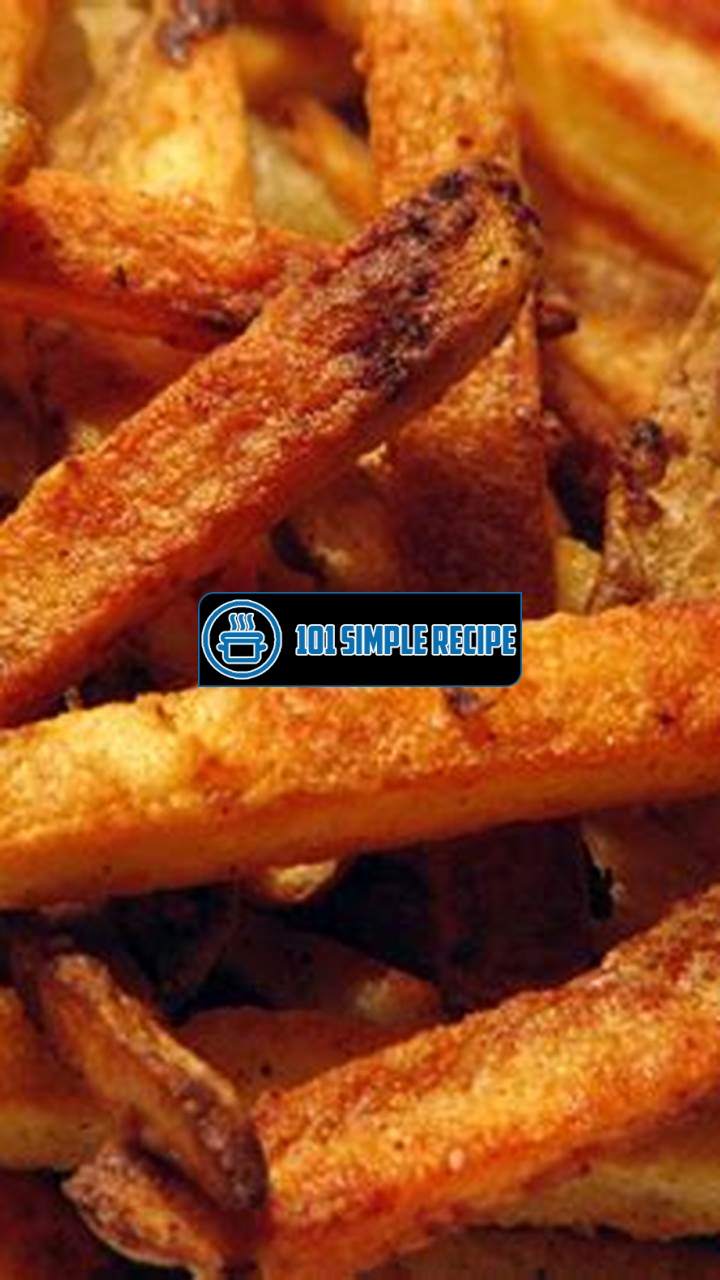If you’re looking for a quick and scrumptious snack, look no further than this easy and delicious French fries recipe! Whether you’re a fan of crispy, shoestring fries or prefer the thick and fluffy variety, this recipe will have you covered. With just a few simple ingredients and some basic kitchen tools, you’ll be able to whip up a batch of fries that rivals your favorite fast-food joint. So, grab your potatoes and let’s get cooking!

History of French Fries
French fries have a long and fascinating history, and they have come a long way to become the beloved dish they are today. Let’s explore their origin and how they have spread all around the world.
Origins of French Fries
The origins of french fries can be traced back to the 17th century in Europe, specifically to Belgium and France. While it’s commonly believed that fries were invented in France, historical evidence suggests that they were first made in Belgium.
The story goes that in the late 17th century, Belgian villagers near the Meuse River used to fry small fish to substitute for their frozen rivers during the winter season. However, in the winter months, the river would freeze, and the fish supply would run low. To survive, the villagers turned to frying potatoes as an alternative. It is here that the humble beginnings of french fries can be found.
These fried potatoes quickly gained popularity and spread throughout the region. The dish was initially known as “frites” or “frieten” in Belgium and “pommes frites” in France, which translates to “fried potatoes” in English. The term “French fries” is said to have originated during World War I when American soldiers stationed in France were introduced to the dish.
Spread of French Fries
As French fries grew in popularity, they made their way across Europe and eventually reached North America. In the United States, french fries became especially popular after Thomas Jefferson, who was the American ambassador to France at the time, encountered them during his visit. He loved the taste so much that he introduced them to the United States, and they soon became a staple in American cuisine.
Over the years, french fries have become an integral part of fast food culture. They are served in almost every burger joint and are often accompanied by various dips, seasonings, and toppings. French fries are known for their crispy exterior, soft interior, and ability to complement a wide range of flavors.
The Connection to Belgium
Despite their name, french fries have a strong connection to Belgium. In fact, fries are considered a national dish in Belgium and are a symbol of Belgian culture. They are traditionally served with mayonnaise or various sauces such as ketchup or tartar sauce.
Belgium takes its fries seriously, and there are even dedicated fry shops called “friteries” where you can find an array of delicious fries. These shops often offer a wide range of sauces and toppings to accompany the fries, making for a unique and flavorful experience.
Today, french fries are enjoyed all over the world. Whether you’re indulging in a classic burger and fries combo or savoring a gourmet twist on the dish, it’s clear that the history of french fries is rich and diverse.
So next time you bite into a crispy, golden fry, remember the humble beginnings of this beloved dish and appreciate the journey it has taken to reach your plate.
Choosing the Perfect Potato
When it comes to making crispy and delicious French fries, choosing the right potato is crucial. Different potato varieties offer varying tastes and textures, and selecting the perfect potato can make all the difference in achieving that coveted crunch. Let’s explore the different potato varieties that work best for creating the ultimate French fry experience.
Taste and Texture Variations
The taste and texture of French fries can vary depending on the type of potato used. Some potatoes are better suited for crispy fries, while others have a creamier texture. It’s important to consider these variations when selecting your potatoes.
- 1. Russet Potatoes: Russet potatoes are a popular choice for making French fries. They have a high starch content and low moisture, which results in a crispy exterior and fluffy interior. Perfect for those who love a classic, crunchy fry.
- 2. Yukon Gold Potatoes: Yukon Gold potatoes are known for their buttery flavor and creamy texture. While they may not crisp up as much as Russet potatoes, they offer a unique and indulgent French fry experience.
- 3. Red Potatoes: Red potatoes have a firmer texture and retain their shape well during the cooking process. This makes them a great choice for thicker-cut fries with a soft interior and a slightly crispy exterior.
- 4. Sweet Potatoes: For those looking for a healthier alternative, sweet potatoes can be used to make delicious fries. They have a distinct sweet taste and offer a nice balance between crispiness and tenderness.
Note: Experimenting with different potato varieties can lead to discovering your own perfect French fry preference! Don’t be afraid to mix and match to find your favorite combination of taste and texture.
Popular Potato Varieties for French Fries
While there are many potato varieties available, some have gained popularity for their exceptional performance when it comes to French fry making.
| Potato Variety | Taste | Texture |
|---|---|---|
| Russet Potatoes | Slightly sweet | Fluffy interior, crispy exterior |
| Yukon Gold Potatoes | Buttery | Creamy interior |
| Red Potatoes | Mild | Firm, soft interior |
| Sweet Potatoes | Sweet | Crispy exterior, tender interior |
Note: These popular potato varieties have been tried and tested by French fry enthusiasts, so you can trust their performance in delivering delectable fries.
Tips for Selecting Potatoes
Now that you’re aware of the different potato varieties suitable for French fries, here are some tips to help you select the best potatoes.
- Choose potatoes that are firm and free from blemishes.
- Look for potatoes with a vibrant color and smooth skin.
- Avoid potatoes with a greenish tint, as this indicates the presence of solanine, a natural toxin found in potatoes.
- If possible, opt for organic potatoes to minimize exposure to pesticides.
- Consider the size of the potatoes. Larger potatoes are easier to cut into fries, while smaller ones may result in crispier fries.
With these tips in mind, you’re now equipped with the knowledge to choose the perfect potatoes for your homemade French fries. Remember, the right potato can take your fries from good to absolutely spectacular!
Mastering the Preparations
Learn the essential steps for preparing the potatoes before they turn into mouthwatering french fries.
Washing and Peeling Techniques
Before you start preparing your delicious french fries, it is important to wash and peel the potatoes properly. This step ensures that your fries are clean and free from any dirt or impurities. Start by rinsing the potatoes under cold running water to remove any surface dirt.
Next, use a vegetable brush to scrub the potatoes gently. This will help remove any stubborn dirt or residue. Pay special attention to the areas around the eyes and crevices of the potatoes. Rinse the potatoes again to make sure all the dirt is washed away.
After washing the potatoes, it’s time to peel them. Use a sharp peeler to remove the skin from the potatoes. Start from the top and work your way down in a smooth motion. Peel off any blemishes or dark spots on the potatoes. Make sure to remove all the skin to achieve that perfect crispy texture.
Remember to wash and peel the potatoes thoroughly to remove any dirt or impurities. This will ensure that your fries are clean and delicious.
Cutting and Shaping Methods
Once you have washed and peeled the potatoes, it’s time to cut them into the desired shape for your french fries. The classic shape is the traditional long and thin strips, also known as shoestring fries. However, you can get creative and try different shapes such as thick-cut steak fries or waffle fries.
To achieve the perfect shape, use a sharp knife or a french fry cutter. Cut the potatoes into slices that are about 1/4 inch thick. Next, stack the potato slices and cut them into long strips. Make sure all the strips are of uniform size so that they cook evenly.
If you prefer thicker fries, simply adjust the thickness of the potato slices. For waffle fries, you can use a waffle cutter to create the unique waffle pattern. Experiment with different shapes and find the one that suits your taste.
Use a sharp knife or a french fry cutter to cut the potatoes into the desired shape. Remember to make uniform cuts for even cooking and try different shapes for variety.
The Importance of Soaking
Soaking the cut potatoes before frying is a crucial step in achieving crispy and delicious french fries. This process helps remove excess starch from the potatoes, resulting in fries that are light and airy on the inside and crispy on the outside.
After cutting the potatoes into the desired shape, place them in a large bowl or container filled with cold water. Let the potatoes soak for at least 30 minutes, or you can even leave them overnight. This soaking process will help remove the starch and ensure that your fries don’t stick together during frying.
Once the soaking time is complete, drain the potatoes and pat them dry using paper towels. Make sure to remove any excess moisture to prevent spattering when frying. Your potatoes are now ready to be cooked to perfection.
Soaking the cut potatoes in cold water helps remove excess starch, resulting in crispy and delicious french fries. Remember to drain and dry the potatoes before frying for the best results.
Secrets to Perfectly Crispy Fries
Uncover the tricks and techniques to achieve that coveted crispy exterior paired with a tender interior in your homemade french fries.
The Science of Deep-Frying
When it comes to creating perfectly crispy french fries, understanding the science behind deep-frying is crucial. The process of deep-frying involves submerging food in hot oil, which causes the water inside the food to rapidly vaporize. This results in a crisp and golden exterior while keeping the interior moist and tender.
One important factor to consider is the temperature of the oil. The ideal temperature for deep-frying french fries is around 350-375°F (175-190°C). At this temperature, the water inside the fries quickly evaporates, creating steam that puffs up the potato’s starches. This creates a light and airy texture on the inside while the exterior becomes crispy.
Another key element in achieving perfectly crispy fries is the starch content of the potatoes. Varieties high in starch, such as Russet potatoes, are ideal for making fries as they have a fluffy texture on the inside and crisp up beautifully on the outside. It’s important to slice the potatoes evenly to ensure even cooking. Soaking the sliced potatoes in cold water for 30 minutes before frying can help remove excess starch, resulting in an even crispier exterior.
Choosing the Right Oil
The choice of oil can greatly affect the flavor and texture of your french fries. Opt for oils with a high smoke point, such as peanut oil, canola oil, or vegetable oil. These oils can withstand the high temperatures required for deep-frying without breaking down or becoming rancid.
Additionally, some oils have a neutral flavor, allowing the natural taste of the potatoes to shine through. Peanut oil, for example, has a high smoke point and imparts a delicious nutty flavor to the fries. Experiment with different oils to find the one that suits your taste preferences.
Timing and Temperature Considerations
The timing and temperature at each stage of the frying process are crucial to achieving crispy french fries. Start by preheating your oil to the recommended temperature of 350-375°F (175-190°C). Placing fries in oil that is not hot enough will result in greasy and soggy fries, while putting them in oil that is too hot will cause them to burn.
When frying, make sure not to overcrowd the fryer or pan. Overcrowding can lower the temperature of the oil and result in uneven cooking. It’s best to fry in small batches, allowing enough space for the fries to crisp up uniformly.
After the initial frying, remove the fries from the oil and let them drain on a paper towel-lined plate or tray. This helps remove any excess oil and prevents the fries from becoming greasy. For an extra crispy texture, you can freeze the partially fried fries for about 20 minutes before frying them again for a shorter period of time.
Finally, season your perfectly crispy fries with salt or any other desired seasonings while they are still hot. The heat helps the seasonings adhere to the fries, giving them an extra burst of flavor.
Note: Achieving the perfect balance of a crispy exterior and tender interior in homemade french fries requires understanding the science of deep-frying, choosing the right oil, and carefully considering timing and temperature throughout the frying process. With these secrets, you’ll be able to enjoy restaurant-quality fries in the comfort of your own home.
So, the next time you’re craving a plate of perfectly crispy fries, remember these secrets and techniques. From the science behind deep-frying to choosing the right oil and mastering timing and temperature, these tips will elevate your homemade fries to a whole new level of deliciousness.
Serving and Seasoning Options
When it comes to enjoying french fries, there are endless possibilities for serving and seasoning them. By exploring a variety of delicious dipping sauces and creative seasoning ideas, you can take your fries to the next level and create a truly memorable experience. Whether you prefer classic flavors or want to try something new and unique, there’s a perfect combination waiting for you.
Mouthwatering Dipping Sauce Recipes
Dipping sauces are the perfect accompaniment to french fries, adding a burst of flavor and enhancing the overall taste. Here are some mouthwatering dipping sauce recipes that you can try:
- Classic Ketchup: Ketchup is a timeless choice, offering a tangy and slightly sweet flavor that pairs perfectly with the crispy texture of fries.
- Garlic Aioli: This creamy and garlicky sauce is a popular option for those who enjoy a rich and savory taste. Its smooth texture and bold flavors make it a great choice for dipping fries.
- Cheese Sauce: If you’re a cheese lover, this sauce is a must-try. Its smooth and velvety consistency, paired with the melted cheese flavor, creates an indulgent experience that elevates your fries to the next level.
- Spicy Chipotle Mayo: For those who enjoy a little kick, this spicy mayo is a perfect choice. The combination of smoky chipotle flavor and the creamy texture of mayo adds an exciting twist to your fries.
- Honey Mustard: If you prefer a balance of sweet and tangy flavors, honey mustard is a fantastic option. The blend of honey and mustard creates a unique taste that pairs exceptionally well with fries.
These dipping sauces are just the beginning, and you can always get creative and experiment with other flavors that excite your taste buds.
Popular Seasoning Blends
Aside from dipping sauces, seasoning your fries with various flavor blends can take them to a whole new level. Here are some popular seasoning blends that you can try:
- Garlic Parmesan: The combination of garlic and parmesan cheese adds a savory and slightly salty flavor to your fries. The aromatic garlic and the nutty taste of parmesan create a harmonious blend that’s hard to resist.
- Truffle Oil and Parmesan: Truffle oil adds a unique earthy flavor to your fries, while parmesan cheese adds a rich and creamy element. Together, they create a luxurious blend that adds depth to every bite.
- Barbecue: For lovers of smoky and tangy flavors, barbecue seasoning is a classic choice. It adds a hint of sweetness and a touch of spiciness, creating a delightful combination that complements the crispy fries.
- Old Bay: This seasoning blend is beloved for its distinct flavor profile, combining celery salt, paprika, and other spices. It adds a zesty and slightly peppery taste to your fries, making them truly irresistible.
- Seasoned Salt: A versatile option, seasoned salt adds a balanced flavor of saltiness, garlic, and other spices. It’s a classic choice that never fails to enhance the taste of your fries.
Feel free to experiment with these popular seasoning blends or create your own unique combination that suits your preferences.
Unique Toppings and Garnishes
In addition to dipping sauces and seasoning blends, you can further elevate your french fries by topping them with unique ingredients or adding garnishes. Here are some ideas to inspire your creativity:
- Loaded Fries: Top your fries with melted cheese, crispy bacon bits, diced onions, and a dollop of sour cream for a hearty and indulgent treat.
- Truffle Mushroom Topping: Sautéed mushrooms in truffle oil, along with a sprinkle of fresh parsley, can add a gourmet touch to your fries. The earthy flavor of mushrooms pairs beautifully with the crispy fries.
- Guacamole and Salsa: For a Mexican-inspired twist, top your fries with homemade guacamole, chunky salsa, and a drizzle of lime juice. The combination of creamy avocado, tangy salsa, and zesty lime creates a burst of flavors. ️
- Buffalo Chicken: Add some diced buffalo chicken, blue cheese crumbles, and a drizzle of buffalo sauce to your fries for a spicy and satisfying meal. The combination of spicy chicken and tangy blue cheese takes your fries to new heights.
- Gourmet Herb Butter: Melted herb butter poured over your fries can add a luxurious and fragrant element. Sprinkle some chopped fresh herbs like rosemary or thyme for an extra burst of flavor.
These unique toppings and garnishes will give your fries an extra layer of excitement and make each bite a memorable one.
With these serving and seasoning options, the possibilities are endless, and you can always tailor them to suit your taste preferences. Whether you’re hosting a party, enjoying a cozy night in, or simply craving a tasty snack, these ideas will surely satisfy your french fry cravings. So, go ahead and unleash your creativity in the kitchen, and elevate your fries to a whole new level of deliciousness!
Thank you for reading this delicious article on the perfect French fries recipe! We hope you have enjoyed learning how to make crispy and flavorful fries at home. Don’t forget to bookmark this page and visit again later for more mouthwatering recipes and cooking tips. Happy frying!
Frequently Asked Questions
Here are some frequently asked questions about making French fries:
| No. | Questions | Answers |
|---|---|---|
| 1. | How do I make crispy French fries? | To make crispy French fries, start by soaking the potato sticks in cold water, then double fry them at different temperatures. This process helps remove excess starch and gives the fries a crispy texture. Make sure to also dry them thoroughly before frying to avoid splattering oil. *Emphasizing important point: Double frying is the secret to achieving perfectly crispy French fries.* |
| 2. | Can I use any potato variety for French fries? | While Russet potatoes are the most popular choice for French fries due to their high starch content, you can also use other varieties like Yukon Gold or Idaho potatoes. The key is to choose potatoes with low moisture content to ensure a crispy exterior. *Emphasizing important point: Choose potatoes with low moisture content for the best results.* |
| 3. | Should I peel the potatoes before making French fries? | Peeling the potatoes is a matter of personal preference. Leaving the skin on adds some extra texture and flavor to the fries. Just make sure to wash and scrub them thoroughly before cutting into sticks. |
| 4. | Can I use an air fryer to make French fries? | Yes, you can definitely use an air fryer to make French fries. It’s a healthier alternative to deep-frying and still gives you crispy results. Just follow the manufacturer’s instructions for cooking time and temperature. |
| 5. | What are some popular seasonings for French fries? | Some popular seasonings for French fries include salt, black pepper, garlic powder, paprika, and herbs like rosemary or thyme. Feel free to experiment and find your favorite flavor combination! |
| 6. | Can I freeze leftover French fries? | Yes, you can freeze leftover French fries. However, they may lose their crispiness upon thawing. For best results, reheat frozen fries in the oven or air fryer to restore their texture. |
Closing Thoughts
Thank you once again for joining us on this French fries adventure. We hope you have learned valuable tips and tricks to create the perfect batch of homemade fries. Remember to play around with seasonings and dipping sauces to make them truly your own. Stay tuned for more exciting recipes and culinary inspiration. Happy cooking, and until next time!
Jump to Recipe
French Fries Recipe

Learn how to make crispy and delicious French fries at home with this easy recipe. Perfect for any occasion!
- 4 large Russet potatoes
- Vegetable oil for frying
- Salt to taste
- Optional: additional seasonings like black pepper (paprika, garlic powder)
- Peel and cut the potatoes into uniform sticks. Place them in a bowl of cold water and let them soak for 30 minutes to remove excess starch.
- Heat the vegetable oil in a large pot or deep fryer to 325°F (160°C). Drain the potato sticks and pat them dry with paper towels. Working in small batches, fry the potatoes for about 5 minutes until they are cooked but still pale. Remove the fries and place them on a paper towel-lined plate. Increase the oil temperature to 375°F (190°C). Fry the potatoes again in small batches for about 3 minutes until they turn golden brown and crispy. Remove them from the oil and drain on a paper towel-lined plate. Season with salt (and any additional seasonings) while they’re still hot.
- Transfer the crispy French fries to a serving dish and serve them hot with your favorite dipping sauce. Enjoy!






